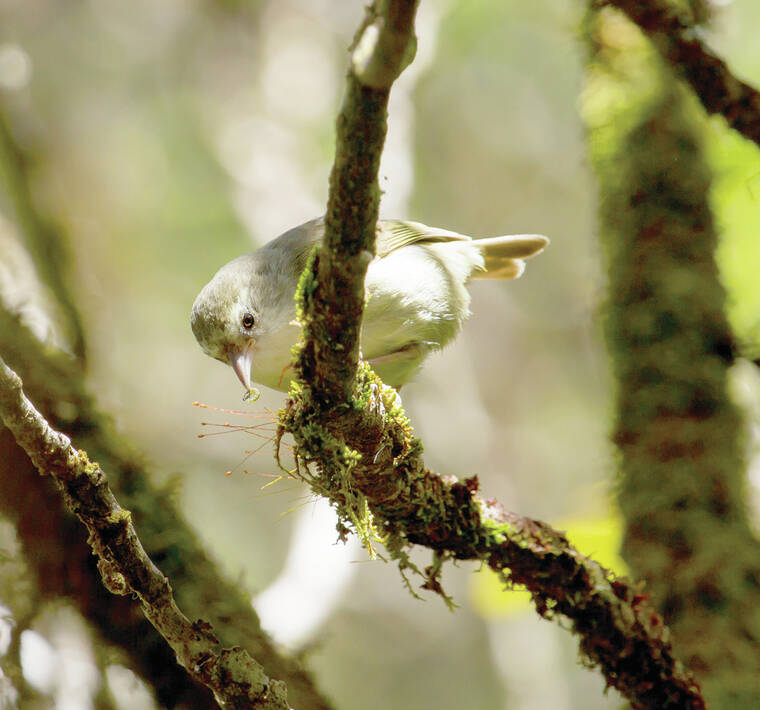LIHU‘E — The Department of the Interior is embarking on a multiagency, multimillion-dollar strategy that aims to prevent imminent extinction of Hawaiian forest birds on Kaua‘i and Maui.
Four honeycreepers — two on Kaua‘i (‘akeke‘e and ‘akikiki) and two on Maui (kiwikiu and ‘akohekoe) — are in danger of extinction in as little as one to two years, according to the department. Additionally, eight other forest bird species risk extinction in the future if no action is taken.
Invasive southern house mosquitoes carrying avian malaria pose the greatest threat to Hawaiian forest bird species, according to the department. Because the mosquitoes can’t live in cooler environments, these birds can now only be found at higher elevations that prove uninhabitable for the mosquitoes.
But as climate change increases air temperatures, the mosquitoes’ habitat continues to grow upward, shrinking the birds’ viable lands.
“The mosquitoes are marching farther and farther uphill, and the birds are basically running out of mountains,” said Bob Reed, deputy director at the U.S. Geological Survey’s Pacific Island Ecosystems Research Center. “For Kaua‘i and Maui in particular, there’s limited habitat left that’s mosquito-free, and so some of these birds that are very, very sensitive to avian malaria are on the verge of blinking out.”
Interestingly enough, one proposed conservation method involves releasing more mosquitoes into the environment — but instead of them carrying avian malaria, they’re infected in a lab with a bacterium called Wolbachia.
“Six out of 10 insects on the planet have the bacterium,” Reed said. “It’s already present in lots and lots of insects in Hawai‘i. All of the southern house mosquitoes in Hawai‘i already have it in them. So it’s not a novel thing introduced to the state. All that’s being done is taking a different strain of Wolbachia and introducing it into male southern house mosquitoes, and then releasing those.”
When mosquitoes carrying distinct Wolbachia strains mate, the resulting eggs fail to hatch, limiting new births and suppressing the mosquito population over time. The technique has been successfully implemented in cities to reduce mosquito-borne disease in humans, but this may mark the first instance in which Wolbachia is utilized for conservation purposes in forests.
“We are trying to refine something that’s been used elsewhere,” said Earl Campbell, field supervisor at the U.S Fish and Wildlife Service’s Pacific Island Fish and Wildlife Office. “So, the parameters aren’t new — the environment is.”
The DOI plans to first release these mosquitoes at Haleakala National Park in East Maui, with potential future implementation in the Alaka‘i Wilderness Preserve on Kaua‘i.
The department isn’t only relying on Wolbachia for its conservation efforts, though. To promote the highest likelihood of species’ survival, multiple strategies are being pursued concurrently, including bringing at-risk birds into captivity.
However, the only two existing captive care facilities in Hawai‘i are already at maximum capacity. While additional facilities on the mainland have offered assistance, many Native Hawaiians consider moving these birds off-island as damaging to biocultural connections. As a result, the department’s strategy aims to build increased capacity for captive care within Hawai‘i, if possible.
“We will have to assess things as stuff is ongoing, what our options are,” Campbell said. “But our very strong preference is, if things are held, that they would be held here.”
Additionally, the DOI is studying the feasiblity of relocating species to the Big Island, where malaria-free higher elevations still exist.
For longer-term conservation efforts, the department is researching synthetic biology strategies — that is, the creation or redesigning of biological systems — as a possible future solution.
“If you can come up with a self-replicating tool, then you could potentially achieve islandwide eradication,” Reed said. “We are a long ways away from that — we have not identified which tools we are likely to pursue, and we don’t have either the scientific or the public input yet that would allow us to make those decisions. But we’re starting discussions with a number of our partners to figure out the next steps toward synthetic biology.”
Over $15 million in investments in fiscal year 2022 — including nearly $14 million in funding from the Bipartisan Infrastructure Law passed last year — have driven the project thus far, spread between the USFWS, USGS, National Park Service and Office of Native Hawaiian Relations.
“The key thing right now is, if we didn’t have that, we would be a lot further behind in trying to work on this issue,” Campbell said.
However, the DOI expects the strategy will require over $55 million in additional investments over the next four years. Still, Campbell notes that to ensure the project’s — and the environment’s — success, federal efforts can’t wait.
“We have a challenge in Hawai‘i,” he said. “We’ve got many, many endangered species. There’s quite a lot, and we need to be able to continue the work we’re doing for plants and snails and other birds, as well as move this issue forward. So, we can’t cut back on the other things. We have no margin. We need to move forward and implement, because we don’t have time to not do this. If we don’t, we’re going to lose these species.”
•••
Jackson Healy, reporter, can be reached at 808-245-0427 or jhealy@thegardenisland.com.


